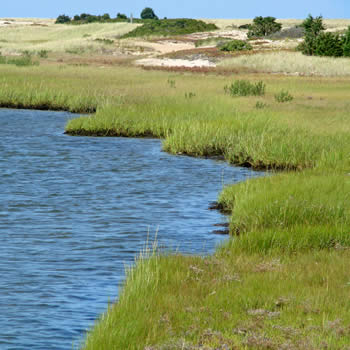Our coastal ponds are in trouble!
 The water quality of most of our saltwater ponds has declined noticeably in the last generation as a result of growth on the Vineyard and beyond. About 64% of the Vineyard’s land area is made up of watersheds that drain into nitrogen-sensitive coastal ponds, either through runoff or groundwater flow. Excessive nitrogen over-fertilizes aquatic plants, resulting in odorous, unattractive ponds devoid of eelgrass, fish, and shellfish, adversely affecting the valuable tourist industry and coastal property values. There are three main sources of excessive nitrogen in our coastal ponds.
The water quality of most of our saltwater ponds has declined noticeably in the last generation as a result of growth on the Vineyard and beyond. About 64% of the Vineyard’s land area is made up of watersheds that drain into nitrogen-sensitive coastal ponds, either through runoff or groundwater flow. Excessive nitrogen over-fertilizes aquatic plants, resulting in odorous, unattractive ponds devoid of eelgrass, fish, and shellfish, adversely affecting the valuable tourist industry and coastal property values. There are three main sources of excessive nitrogen in our coastal ponds.-
Atmospheric Sources: Rain deposits nitrogen from polluted air, largely from upwind coal-fired power plants and other industrial sources off-Island. (On average, this represents 29% of nitrogen pollution though the proportions vary considerably between watersheds.)
-
Wastewater: By far the greatest source of "manageable" (i.e. non-atmospheric) source of nitrogen pollution in our ponds comes from the urine in wastewater. About 90% of Vineyard homes have their own on-site Title 5 septic systems that deal well with pathogens but have little impact on nitrogen. (62% of nitrogen pollution).
-
Fertilizer: Much of the nitrogen-based fertilizer used on lawns, gardens, and farms ends up in the water table where it drains into ponds (9% of nitrogen pollution).
What can we do?
The Martha's Vineyard Commission has worked for many years with towns, pond associations, and the Massachusetts Department of Environmental Affairs (DEP) to gather and analyze data and identify the best ways to deal with this challenge. The Massachusetts Estuaries Project (MEP) is analyzing most Vineyard coastal ponds in order to establish safe levels of nitrogen loading and identify the most cost-effective ways to meet these levels. DEP then establishes the Total Maximum Daily Load for each pond. Some ponds are already over these limits, others are projected to exceed their limits with future development, and others can accommodate all projected growth without exceeding their limits.
We need to identify the lowest-cost ways to reduce nitrogen-loading so that the ponds meet their Total Maximum Daily Load and start implementation, to avoid having DEP or the courts impose measures that may be much more costly and may conflict with other community objectives. The following are possible ways to deal with the manageable portion of excessive nitrogen.
-
Wastewater Treatment: Nitrogen can be reduced at the source with techniques such as composting or urine-separating toilets. Wastewater can be treated to reduce nitrogen, such as with sewering and centralized treatment that removes about 95% of the nitrogen or DEP-approved on-site innovative alternative septic systems that remove about 40-50% of the nitrogen, compared to standard Title 5 systems. Both methods are costly to install and maintain.
-
Tidal Flushing: Improving water circulation to the sea with widened inlets or more pond openings can help dilute the nitrogen in the pond.
-
Landscaping and Fertilizers: A number of landscaping techniques can be used to reduce nitrogen, including reducing the use of fertilizers and designing landscaping so the effluent from septic systems passes through vegetation where it is converted into gases taken up in the atmosphere.
-
Aquaculture: Growing oysters and other shellfish can reduce nitrogen in a pond, though this is not yet recognized by DEP.
-
Growth Management and Nitrogen Limits: Board of health and zoning regulations can be used to limit the nitrogen that will be generated in nitrogen-sensitive watersheds in the future, such as by limiting the number of bedrooms in a house, limiting how much nitrogen a new project can generate, and/or requiring that the nitrogen generated by a development project in a critical watershed is offset with nitrogen reduction elsewhere in the watershed. Land acquisition for open space also reduces the generation of nitrogen.

